10 Best Low-Impact Exercises for Weight Loss

Let’s uncover the truth: low-impact exercises aren’t dull; they’re your ticket to shedding pounds. Incorporating these gentle yet effective movements into your fitness routine can work wonders for weight loss while being easy on your joints. That’s why I’ve rounded up 10 of the best low-impact exercises for weight loss you can possibly do.
In the realm of low-impact workouts, versatility reigns supreme. Contrary to popular belief, these exercises deliver substantial benefits to your body, both in the short and long term. You can achieve results comparable to high-impact workouts without worrying about beating up your body. Moreover, low-impact exercises have a knack for raising and maintaining your heart rate, making them ideal for building endurance. This means you can simultaneously push your limits while pursuing your weight-loss goal.
Whether you’re just starting your fitness journey or you’re a seasoned gym-goer, incorporating low-impact exercises into your routine is a smart move. Allow me to guide you through some of my favorite low-impact exercises for weight loss that can be seamlessly integrated into your weekly workouts, used as cardio finishers post-strength training, or enjoyed as enjoyable and effective active recovery sessions.
Battle Ropes
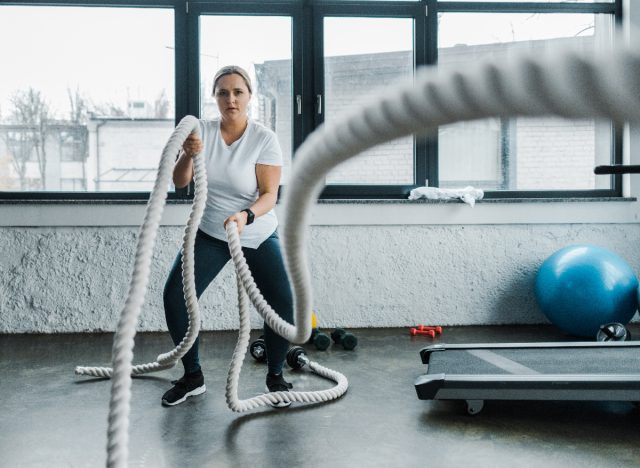
Battle rope workouts offer an excellent, low-impact solution for achieving your weight-loss goals. Their rhythmic, full-body movements engage multiple muscle groups without placing undue stress on joints, making them suitable for individuals of varying fitness levels. Combining cardiovascular benefits with calorie-burning intensity, battle rope exercises provide an efficient and effective way to shed pounds while improving overall fitness and endurance.
For an AMRAP (As Many Rounds As Possible) style, aim for 10 to 20 repetitions of your preferred battle rope variation to push your limits and build endurance. Alternatively, you can opt for circuits structured with work and rest intervals, such as 30 seconds of intense effort followed by 30 seconds of rest, repeating for eight to 12 rounds.
Cycling
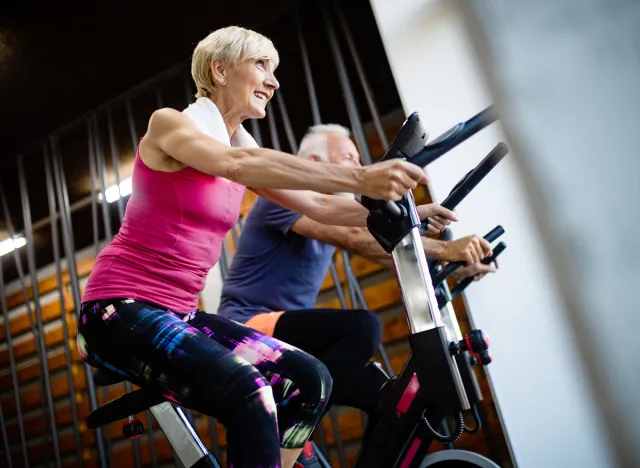
Cycling is a top-notch option for a low-impact workout to boost metabolism. The advantages remain steadfast whether you’re exploring the outdoors or pedaling away on a stationary bike indoors. This activity engages crucial lower-body muscle groups like the quads, hamstrings, and calves, facilitating gradual strength and endurance gains. What makes cycling so remarkable is its adaptability. It accommodates diverse fitness levels and preferences, empowering individuals to customize their workouts for optimal results.
Hop on a bike for a steady-state workout lasting 30 to 60 minutes to build your endurance base and hit that Zone 2 sweet spot for weight loss. When you’re ready for a new challenge, switch things up with 15 to 20 intervals consisting of 40 seconds of high-intensity effort followed by 20 seconds of an easy pace. Cycling is especially beneficial when aiming for a gym session but still recuperating from an upper-body workout the day before.
Rowing
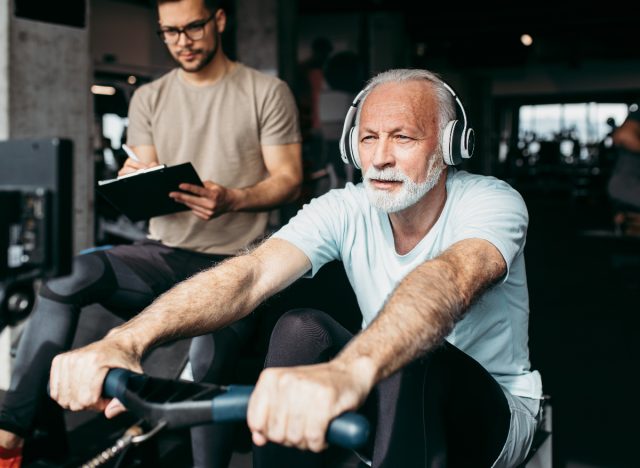
Rowing is a fantastic, low-impact exercise that maximizes calorie-burning potential. The rowing motion engages the entire body, from the legs and core to the arms and back, making it a comprehensive workout with minimal stress. This full-body movement torches calories efficiently and builds strength and endurance over time, making rowing an excellent option for those seeking practical and sustainable weight loss.
Begin this weight-loss workout on the rower with a thorough warm-up lasting around five minutes, rowing at a moderate pace to prepare your body for the upcoming intensity. Then, transition into the main workout by rowing at maximum effort for 30 seconds. Following each high-intensity interval, allow one minute of easy rowing or complete rest to catch your breath and partially recover before the next burst of effort. Repeat these intervals for 10 to 15 minutes, focusing on pushing yourself to your limits during the intense phases. Finally, conclude the workout with a five-minute cool-down period.
SkiErg
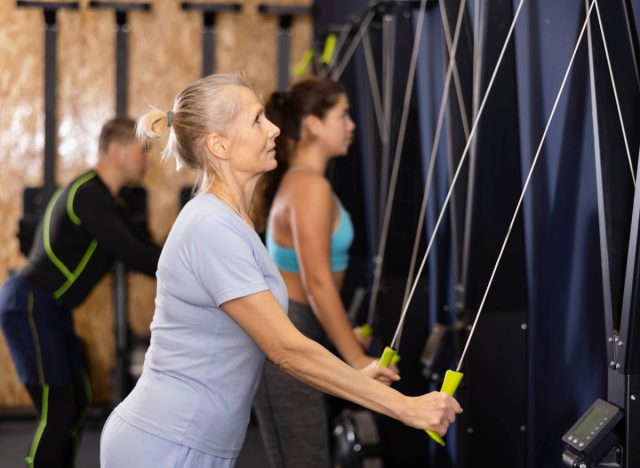
SkiErg workouts present an outstanding, low-impact approach to maximizing calorie burning. Their smooth, fluid motion engages multiple muscle groups without straining the joints, making them perfect for effective weight-loss routines. This full-body movement efficiently burns calories while enhancing cardiovascular health and endurance. Plug SkiErg workouts into your cardio days, HIIT intervals, or as a quick finisher after a strength training routine.
Start your SkiErg workout with a five-minute warm-up, maintaining a steady pace to prepare your body for the intensity ahead. Then, transition into the main workout by performing intervals of high-intensity skiing for 30 seconds, followed by 30 seconds of rest or low-intensity skiing for recovery. Repeat these intervals for 10 to 15 minutes, focusing on pushing yourself during the intense phases while allowing adequate recovery between sets. Conclude the workout with a five-minute cool-down
Kettlebell Swings
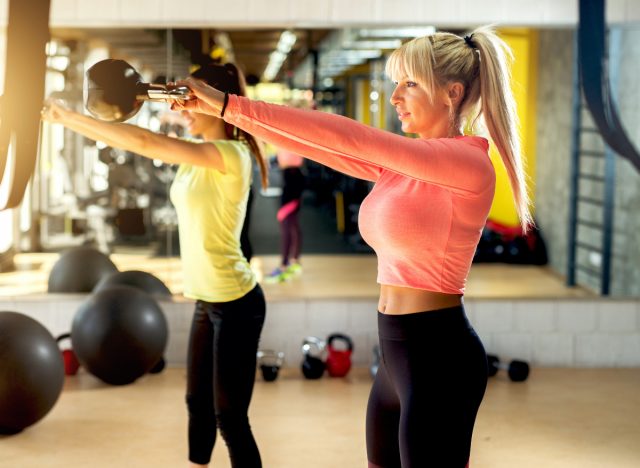
The kettlebell swing is a low-impact exercise renowned for its fluid, controlled movements that minimize joint stress. This exercise primarily engages the posterior chain muscles, including the glutes, hamstrings, lower back, core, shoulders, and forearms. This full-body engagement makes kettlebell swings an efficient workout for strength and cardiovascular fitness.
For weight loss, kettlebell swings elevate the heart rate, promoting calorie burn while simultaneously building muscle mass, which boosts metabolism and calorie expenditure even at rest. Incorporating kettlebell swings into a routine offers a dynamic and effective approach to overall fitness and weight management and provides multiple exercise variations to use in your workouts.
For a fun variation from the usual sets and reps, strive to finish as many rounds of 10 swings as possible within 10 minutes. Take short breaks of 10 to 15 seconds between sets, or extend them as necessary to maintain form and intensity.
Stairmaster

Stairmaster workouts emerge as a stellar choice for individuals seeking low-impact weight-loss workouts. The rhythmic stair-climbing motion engages major muscle groups while minimizing impact, making it an ideal option for those with joint sensitivities or recovering from injuries. This full-body workout burns calories effectively and enhances cardiovascular endurance, fostering a holistic approach to achieving weight-loss goals. You can perform steady-state or interval workouts and even ramp up the intensity by adding a weighted vest.
Start with a five-minute warm-up on the Stairmaster at a moderate pace to prepare your body. Then, alternate between periods of high-intensity stair climbing and recovery. For example, climb at a fast pace for one minute, followed by two minutes of slower climbing or rest. Repeat this pattern for 20 to 30 minutes, gradually increasing the intensity of your high-intensity intervals as you progress.
Shadow Boxing

While boxing might appear high-impact, it can be adapted to offer a low-impact workout ideal for weight loss. By focusing on controlled movements like shadow boxing, individuals can engage in punching techniques without heavy impact, reducing strain on the joints. Additionally, continuous boxing movements, such as punching combinations and footwork drills, elevate the heart rate and promote calorie burning without needing high-impact activities like jumping or running. This full-body workout engages multiple muscle groups, including the core, arms, shoulders, and legs, contributing to muscle growth and increased metabolism for effective weight loss.
Here’s a shadow boxing workout designed to maximize calorie burn and aid in weight loss. Begin with a five-minute warm-up, then progress through four rounds of shadow boxing. Start with basic boxing movements, focusing on form and technique in the first round. Increase the speed and intensity of your punches in the second round, followed by high-intensity cardio intervals in the third round to elevate your heart rate. In the final round, emphasize power punches to build strength and endurance. Finish with a five-minute cooldown, including gentle stretches to improve flexibility and prevent injury.
Yoga
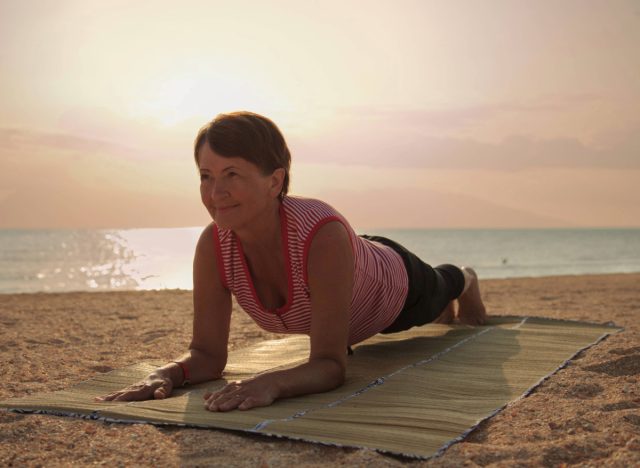
When it comes to weight loss, yoga offers a distinct approach compared to traditional cardio exercises. Through a series of dynamic poses and flows, it enhances mobility, isometric strength, and muscle conditioning. Certain yoga practices stand out for those seeking weight loss, such as vinyasa or power yoga, which combine flowing movements with strength-building poses to increase heart rate and calorie burn effectively.
Engage in a flowing sequence of your preferred yoga poses, taking several deep inhales and exhales in each position. Strive for a continuous, active practice lasting 10 to 30 minutes, focusing on fluid movement and mindful breathing throughout. Better yet, hit up one of your local yoga studios to get instructed by a certified professional.
Elliptical
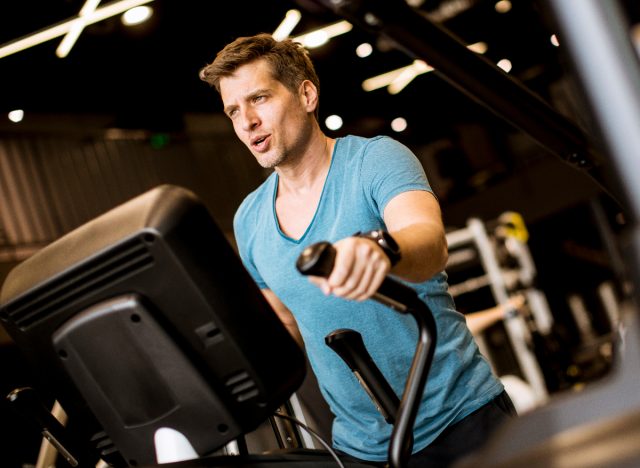
Ellipticals are fantastic tools for weight loss, providing accessible and versatile low-impact workouts. They excel in building muscular endurance while offering alternatives to high-impact cardio exercises. With a smooth, gliding motion mimicking walking, jogging, or running, ellipticals spare the joints from the impact often associated with outdoor activities. This feature caters to individuals of all fitness levels, including those with joint issues or injuries. Moreover, ellipticals come with adjustable resistance levels and incline settings, enabling users to customize their workouts according to their weight-loss goals and personal preferences.
Maintain a steady pace for 30 to 45 minutes at a moderate intensity. Focus on elevating your heart rate while engaging your legs, arms, and core muscles throughout the workout. Alternate between high-intensity intervals and recovery periods. For example, sprint at maximum effort for one minute, followed by one minute of easy-paced recovery. Repeat this cycle for a total of 20 to 30 minutes.
Swimming
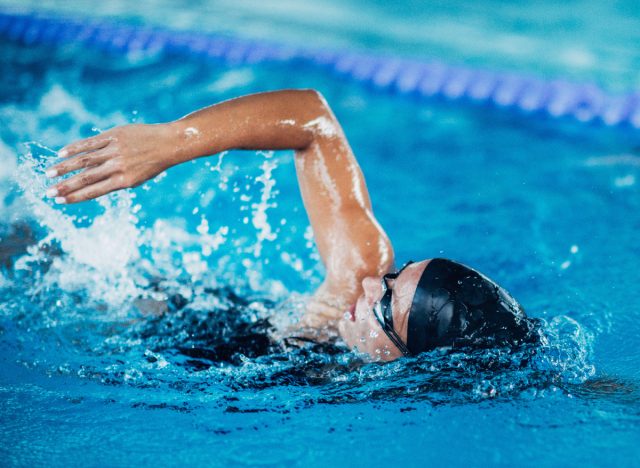
Swimming is an excellent weight-loss choice, albeit not the most accessible to some. Swimming offers many benefits for weight loss, muscular endurance, mobility, and joint health. The water’s resistance provides a challenging yet gentle workout for muscles throughout the body, including the arms, legs, core, and back.
Furthermore, the buoyancy of water alleviates strain on joints, making swimming an appealing option for individuals with joint issues or those seeking rehabilitation-friendly exercise. Plus, the range of motion required for swimming strokes enhances flexibility and mobility, contributing to overall physical well-being and facilitating weight loss.
Aim to swim continuously for 20 to 30 minutes at a moderate pace for a weight loss-focused swim workout while concentrating on steady breathing and rhythm. Vary your strokes between freestyle, breaststroke, and backstroke to engage different muscle groups.
Alternatively, complete 10 to 12 rounds of 50-meter sprints for an interval-based session, with 20 to 30 seconds of rest between each sprint. Maintain high intensity during the sprints by utilizing your preferred stroke or alternating between strokes for added variety and challenge.





